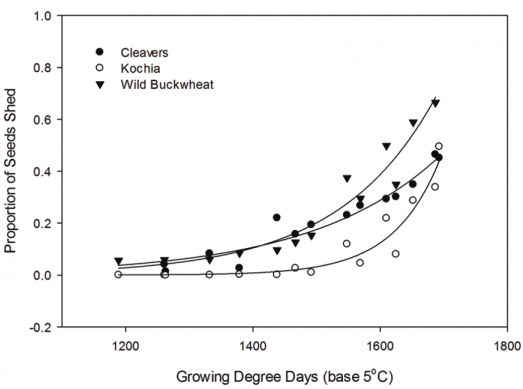Harvest tips for weed seed management
Key Result: If one goal at harvest is to reduce the weed seed bank, producers should focus their efforts on harvesting canola as soon as the crop is mature with the aid of chaff collectors or pulverization techniques. For the majority of producers not using these types of equipment, an alternative strategy might be to delay harvest to allow weed seeds to be shed where the mother plant grew. This will aid in keeping herbicide resistant weeds such as wild buckwheat and cleavers in patches instead of spreading them throughout the field with
the combine.
Project title, Principal investigator: “Can harvest weed seed management be used to control kochia, cleavers and wild buckwheat?” Steve Shirtliffe, University of Saskatchewan
Funding: Alberta Canola, SaskCanola, Manitoba Canola Growers
In recent years herbicide-resistant weeds have become increasingly problematic in canola. Harvest weed seed management has emerged as a strategy to manage herbicide resistance and hard to kill weeds. The objective of this study was to evaluate the potential of harvest weed seed management techniques to manage seed production of cleavers, kochia and wild buckwheat in canola.
Two experiments were conducted in 2014, 2015 and 2016 in central Saskatchewan with the following objectives:
1. Determine the timing of seed shed in cleavers, kochia and wild buckwheat growing in canola.
2. Assess the efficacy of pre-harvest herbicides in reducing viable weed seed production in cleavers, kochia, and wild buckwheat.
For the first experiment, the timing of seed shed was sampled for both naturally-occurring weed populations and transplanted weeds. Since natural and transplanted weed populations differed in the timing, proportion and number of seeds shed, data from natural weed populations were taken to be most accurate.
Harvest timing and weed seed shed
Weed seed shed response was linked to growing degree days (GDD). Seed shed of cleavers and wild buckwheat began at approximately 1,390 GDD, which coincided with the last week of August in 2015, and the third week of August in 2016. Kochia seed shed began at approximately 1,585 GDD, which coincided with the last week of September in 2015 and the second week of September in 2016.
If the canola crop was harvested in mid-September, approximately 73 per cent of cleavers, 65 per cent of wild buckwheat and 90 per cent of kochia seeds would remain on weed plants. If harvest was delayed to the end of September, approximately 54 per cent of cleavers, 32 per cent of wild buckwheat and 56 per cent of kochia seeds produced would remain on the weed plants.
Kochia, however, shed a much larger number of seeds than cleavers and wild buckwheat over the course of the experiment, averaging approximately 20 times more seed per plant. Therefore, at 1,390 GDD the three weed species had shed a similar number of seeds (≤55 seeds per plant), despite the fact that 99 per cent of seeds remained on kochia plants.

Pre-harvest herbicides may not reduce weed seed bank
In the second experiment, the efficacy of diquat and glyphosate in reducing weed seed production and viability was tested. Pre-harvest herbicides were applied at the recommended canola swathing stage of 60 per cent seed colour change on the main stem.
The results found that a pre-harvest herbicide application did not reduce the number of seeds shed by harvest time for cleavers, kochia or wild buckwheat. This suggests that herbicide application at canola swathing time is not early enough to prevent seed formation for the three weed species tested.
Viability of seeds produced in untreated plots and those treated with pre-harvest herbicides was tested in 2016, but did not differ between treatments. This is consistent with observations that seeds had already produced mature seed by the time of pre-harvest herbicide application.
For cleavers and kochia, there was a trend of higher seed shed by plants treated with diquat than the untreated control. This trend can likely be attributed to diquat accelerating dry-down of weeds that had already produced mature seeds, causing premature shattering.
The researchers concluded that farmers can save time and money by avoiding pre-harvest herbicide application as a weed-seed control measure, and focus instead on harvest timing. Harvesting as soon as the crop is mature with the aid of chaff collectors or pulverization (seed destructor) equipment can help collect and destroy the majority of seeds produced by these three weed species. Alternatively, if chaff collection or pulverization equipment is not used, delaying harvest will allow more weed seeds to be shed where the mother plant grew. This tends to keep herbicide-resistant weeds in patches instead of having the combine spread these seeds throughout the field. Delayed harvest will aid in containing wild buckwheat and cleavers seeds, but have limited efficacy in containing kochia seeds, due to the large number of seeds remaining on the plant in the fall, and its tumbling method of seed dispersal.





